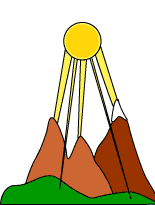|
Where and how you spend your vacation
You might wonder why we added vacations to the list of risk factors. Vacation is what we all look forward to, since it is the time we use to relax, forget about work and many of us like to spend time outdoors especially when it is warm and sunny outside. We do not want to make your vacation miserable but we urge you to have a sun-smart vacation. There are a few things you should know to help you do so:
Where you plan to spend your vacation
Whether you want to spend your vacation at home or travelling to protect yourself from UV radiation is an important issue.
Equator Proximity
UV protection becomes even more important the closer you are to the equator. The equator is the zone where the sunīs light hits the earth at a very steep angle which increases the intensity of UV radiation.
Composition of ground
If you plan to spend your vacation on the beach or in the snow, remember that not only the light that comes from above can be harmful, but reflected light can cause just as much or even more damage. The smoother and lighter the ground, the more light will be reflected. Just a few examples are water, sand at the beach and snow. Sand increases UV radiation through reflection by 25 %, snow by as much as 85 %.
Altitude
 |
It makes quite a difference whether you spend your vacation at sea level or in the mountains. At 1,000 m (3,280 ft.) UV radiation is increased by approximately 5-8 %. Be aware that time spent at high altitude should be spent cautiously: use a high SPF sun protection or take other preventive action, such as seeking shade, wearing long-sleeved shirts and pants.
Holidays:
The time of year
It makes a big difference whether you travel in the summer- or winter. Sun radiation is more intense in summer than in winter.
The time of day
From sunrise to sunset the sun follows a virtual semicircle. It will reach its highest point just around this time. The sunīs radiation will hit the earth at a very steep angle. The steeper the angle, the stronger the intensity of UV radiation. Therefore you should avoid the sun during 10 a.m. and 4 p.m.TD>
|
